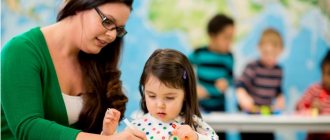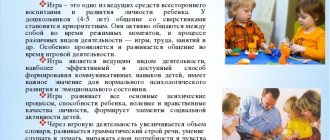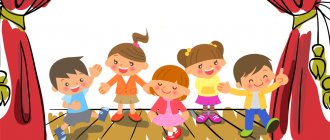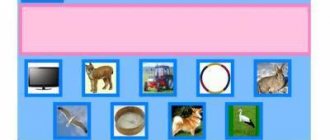Definition 1
Independent mathematical activity is work on the practical implementation of acquired mathematical knowledge and concepts during the educational process.
The knowledge acquired in mathematical classes, concepts and categories are transferred to the child’s activities.
The mathematical development of preschoolers is a necessary and conditioned direction of their overall development, implemented at the preschool stage of education.
Knowledge of the basics of mathematics and the formation of elementary mathematical concepts is necessary to prepare a child for school, develop the foundations of independence and lay the foundation for the formation of logical thinking.
All this determines the active development of independent mathematical activity of preschoolers, which deepens mathematical knowledge, makes mathematical concepts stronger and forms the desire of preschoolers to understand mathematical science.
Are you an expert in this subject area? We invite you to become the author of the Directory Working Conditions
Features of organizing independent mathematical activities of preschool children
Independent mathematical activity of preschoolers can have different contents and different directions. At the same time, it is characterized by its occurrence on the initiative of the child himself and its implementation without the participation of an adult.
The features of preschoolers’ implementation of independent mathematical activities are the following:
- Indirect participation of an adult: teacher or parent.
- A game form of implementing mathematical activities.
- Freedom for the child to choose the topic of the lesson, the features of its implementation, the period of implementation, etc.
- Creative approach to implementation of activities. Preschoolers find ways to perform specific mathematical operations, activating their creative thinking.
- Availability of performing actions used in the gaming mathematical process.
- Formation of skills in organizing, planning and implementing diverse types of activities.
- The child takes a subject position in this activity, i.e. he himself sets its goal, determines the content and methods of its implementation, and also sums up the results of the implementation of the activity.
Finished works on a similar topic
Course work Organization of independent mathematical activity of preschool children 490 ₽ Abstract Organization of independent mathematical activity of preschool children 220 ₽ Examination Organization of independent mathematical activity of preschool children 190 ₽
Receive completed work or specialist advice on your educational project Find out the cost
Directions for implementing independent mathematical activities of preschoolers
Independent mathematical activities of preschoolers are implemented by preschool teachers in the following areas:
- Creation of a mathematical zone in a preschool educational institution. It is included in the subject-development environment and allows children to realize their mathematical abilities and imagination in independent activities. The components of such a zone are mathematical and logical games, materials for performing various mathematical operations: sticks, abacus, cubes, numbers, figures of various shapes, puzzles, Dienesh logic blocks, etc.
Figure 1. Creation of a subject-development environment. Author24 - online exchange of student work
- Organization of interaction with parents of students. It is aimed at creating a unified direction for the mathematical development of children, involving parents in the work of activating the mathematical interest of children, and implementing various types of mathematical activities at home. For this purpose, conversations are organized with parents, advisory sessions are held with them, mathematical events are organized with the involvement of parents, didactic games and exercises for parents are organized.
- Carrying out various forms of work with preschoolers to develop their creative abilities and independence skills.
All these areas make it possible to form mathematical concepts in preschoolers, which will become the basis of their independent activity, develop the need for knowledge of mathematical science and ensure the preparation of children for the start of school. At the same time, it is independent mathematical activity that directly depends on the forms and methods of mathematical teaching of children, the formation of elementary mathematical concepts in them.
“Organization of independent activities of children in preschool settings” consultation on the topic
Organization of independent activities of children in preschool educational institutions.
One of the main forms in the process of education and upbringing of children in kindergarten is the independent activity of children. Before moving on to the issue of organizing this independent activity in a preschool educational institution, I will talk about what needs to be understood by independence.
About the concept of “independence” in scientific literature
In the scientific pedagogical literature there are different points of view on the definition of the concept of “independence”
1. This is the ability not to be influenced by various factors, to act on the basis of one’s views and beliefs.
2. This is a general characteristic of a person’s regulation (management) of their activities, relationships and behavior.
3. This is a gradually developing quality, a high degree of which is characterized by the desire to solve problems of activity without the help of other people, the ability to set a goal for an activity, carry out basic planning, implement what was planned and get a result adequate to the goal, as well as contribute to the manifestation of initiative and creativity in solving emerging problems.
Scientific research indicates that under conditions of optimal upbringing and training, children can achieve a certain level of development of independence in various types of activities: gaming, communicative, motor, cognitive and research, productive (drawing, modeling, artistic work), labor, musical and artistic. , reading.
The development of independence is facilitated by children mastering the ability to set a goal (or accept it from a teacher), think about the path to achieving it, implement their plan, and evaluate the result from the position of the goal.
Thus, the independent work of children in a preschool educational institution is work that is carried out without the direct participation of the teacher, on his instructions, in the time specially provided for this, while the child consciously strives to achieve the goal, using his efforts and expressing in one form or another the result of mental or physical actions.
A. I. Zimnyaya emphasizes that performing such independent work requires a fairly high level of self-awareness, reflexivity, self-discipline, personal responsibility, and gives the child satisfaction as a process of self-improvement and self-knowledge.
So: independent activity of children is one of the main models for organizing the educational process of preschool children:
1) free activity of pupils in the conditions of a subject-specific developmental educational environment created by teachers, ensuring that each child chooses an activity based on his interests and allows him to interact with peers or act individually;
2) activities of pupils organized by the teacher, aimed at solving problems related to the interests of other people (the emotional well-being of other people, helping others in everyday life, etc.).
On the role of the teacher in organizing children’s independent activities.
The teacher must create a diverse gaming environment (we are talking about a subject-development environment in a preschool educational institution), which should provide the child with cognitive activity, must correspond to his interests and be developmental in nature. The environment should provide children with the opportunity to act individually or together with peers, without imposing mandatory joint activities.
The teacher can get involved in the activities of children in cases of conflict situations that require the intervention of an adult, or, if necessary, help a particular child join a peer group.
The subject-development environment should be organized in such a way that every child has the opportunity to do what he loves. Such an environment must meet the individual and age characteristics of children and their leading activity – play.
It is the modeling of the game of the child’s choice, his scenario, that contributes to the development of creative abilities, awakens imagination, activity, teaches communication, and vivid expression of one’s feelings.
Play in kindergarten should be organized, firstly, as a joint game between the teacher and the children, where the adult acts as a playing partner and at the same time as a carrier of the specific “language” of the game. The natural emotional behavior of the teacher, who accepts any children’s plans, guarantees freedom and ease, the child’s enjoyment of the game, and contributes to the desire in children to master the methods of play themselves. Secondly, at all age stages, play should be preserved as a free independent activity of children, where they use all the play tools available to them, freely unite and interact with each other, where the world of childhood is ensured to a certain extent, independent of adults.
Along with play, free productive activity of children (constructive, visual, etc.) occupies a significant place in a child’s life. Just like in play, the child’s development opportunities are enriched here.
The teacher can plan in advance the independent activities of children, taking into account the topic that is relevant for a given day (or week), the set goals and objectives of educational work during the day, that is, the principle of a comprehensive thematic structure of the educational process in a preschool educational institution must be implemented. The teacher “starts” from this topic when organizing children’s independent activities.
And so, I want to offer you, for example, in the senior group the theme of the week “Dear Maslenitsa is coming...”
Try to organize independent activities for children:
1. The day before, in the group, organize an exhibition “Maslenitsa Doll” using demonstration material: paintings, children's drawings, newspaper clippings, children's books, rag dolls.
2. Introductory conversation between the teacher and children on the topic.
The purpose of both exhibitions and conversations: to motivate children to study independently, to review demonstration material.
3. Add materials of various properties for artistic creativity (pencils, brushes, paints, wax crayons, paper for appliqués). Using the pedagogical method of advance payment (i.e., praising the child in advance, making him believe in himself), the teacher motivates children for independent artistic creativity (appliqués “Sun”, drawings “Maslenitsa Doll”, etc.)
4. While walking, tell the children about the rules of the outdoor holiday game (which is played on Maslenitsa): a goat walked through the forest, a freckle meant spring, cold was hot. And invite them to play them themselves, as well as tell other children about the games and play together.
5. Children, if desired, take pre-made “Sun” crafts and through these crafts the teacher can encourage round dance games. (The role of the teacher is to guide, the children do the rest themselves)
6. In the “Housewife” corner, invite the children to bake pancakes (after reading fiction, chants and poems about pancakes), s.r.i. "Culinaries"
Thus, the teacher should devote a large amount of time during the day to organizing the independent activities of children in preschool educational institutions. And if in joint activities with children the teacher is an equal partner, then in independent activities the teacher is only an observer.
The prepared environment includes didactic materials that can be divided into three main groups: practical life exercises, which three and four-year-old children begin with; sensory materials that children of any age work with; educational materials that meet children's interests in counting, reading, and studying the world around them. All materials are designed for the child’s zone of proximal development, which promotes free cooperation of children, absence of competition, and social development of the child.
All materials are on open shelves and freely accessible to children. Each material is present in a single copy. If a child wants to take material that is already covered, he can wait, or study with other material, or try to work together with a friend - if, of course, he does not object and the material allows it. In this way, the child learns to behave in society.
When a child comes to a group, he chooses an activity that is relevant to him; the ability to self-control when working with materials helps him feel independent and self-reliant. Three-year-old children love to study in the practical zone, performing exercises that mothers do not always allow at home: washing, washing dishes, ironing, and all this with real objects (Appendix). They also learn to fasten buttons, zippers, cut fruit, and even hammer nails. All these exercises help the child learn to take care of himself.
A group of sensory materials gives the child the opportunity to use his senses to explore the world around him. Here the child learns to distinguish the height, length, color, shape, noise, and weight of various objects. In this zone, the baby not only develops his senses, but also refines them.
The group of training materials includes:
– introduction to mathematics – introduction to numbers, the decimal system, examples of addition and subtraction,
— introduction to the Russian language – exercises for developing fine motor skills and preparing the hand for writing, familiarization with printed and capital letters, flashcards.
– introduction to geography – globe, maps of continents,
- introduction to biology and zoology - plant and animal puzzles, animal figurines.
The entire subject-developmental environment of the group takes into account the age-related interests of the development of children's activities and corresponds to the child's capabilities.
Also, the subject-development environment changes depending on the topic of educational activity:
In conclusion, I would like to note that thanks to the transition to a new form of calendar planning, the organization of independent activities is clearly reflected and intersects (integrates) with other forms of work during the day (walking, routine moments, group - subgroup, joint activities). But in comprehensive thematic planning of preschool educational institutions, there is no emphasis on the independent activities of pupils; this activity is not separately prescribed, but only implied. Consequently, the following question remains open: the inclusion of the section on organizing independent activities in the comprehensive thematic planning of preschool educational institutions.
List of used literature:
1. Kononova I., Ezhkova N. Preparing children for independent activities. // Preschool education, 1991 - No. 6. - P. 11-14
2. Educational environment and organization of independent activities of senior preschool age [Text]: methodological recommendations / ed. O.V. Dybina/-M.: Center for Pedagogical Education, 2008.
3. Raising preschoolers to be independent: Collection of articles - Russian state. Ped. Hertzin University, St. Petersburg: Detstvo-PRESS 2000-192 p.



